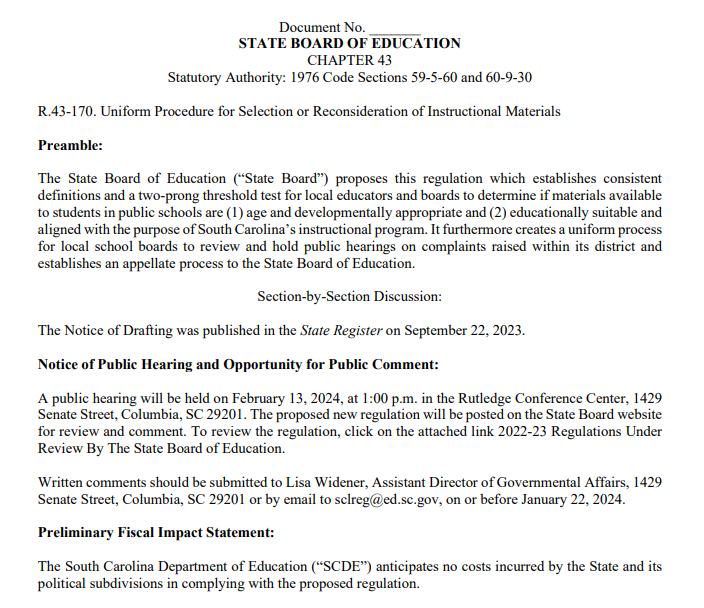School Ratings Must Not Be Ambiguous

Dr. Oran Smith
On October 3, Palmetto Promise’s Dr. Oran Smith addressed the SC Education Oversight Committee concerning education accountability standards required of states in compliance with the Every Student Succeeds Act (ESSA), signed by President Obama in 2015. The following is an edited transcript of those remarks.
Members of the Committee…
The message I have for you on accountability is a broad, general one that rests on two goals – a system that boldly rewards excellence with transparency and a system that accounts for value added.
First, boldly rewarding excellence with transparency means embracing A-F grading for our schools. You may ask why Palmetto Promise Institute believes this is the best system.
Let me share four reasons with you:
1. Boldly rewarding excellence with transparency means not fearing our demographics.
Palmetto Promise Institute cut its teeth on public policy with a white paper comparing our experience in SC since 1999 with the State of Florida.
That was a good choice of aspirant state because Florida was behind South Carolina in 1999—and Florida spends about what we do, actually a bit less per pupil. Florida is a majority-minority student population, with minority students making up 60 percent of their total enrollment, and 58 percent of Florida students living in poverty. The state has a large population of migrant families for whom English is a second language. And Florida pursued a bold reform agenda including an A-F school accountability system.
The Florida experience has shown that demography is not destiny. The achievement gap is a reality for all states, but Florida’s reforms have helped close it. According to the 2013 “Nation’s Report Card” National Assessment for Education Progress (NAEP) data, Florida’s most challenged students showed more improvement than our total student population. Florida’s experience also demonstrates that low income and high minority populations do not necessarily equal low student performance.
Even with the demographic challenges, of the Florida schools that earned an A or B in 2011-2012:
- 61% were schools where at least half of the students were from low-income families
- 49% were schools where at least half of the students were a minority
- 40% of A and B schools in Florida were schools where at least half of the students were low-income AND minority students
2. Boldly rewarding excellence with transparency means choosing an unambiguous system parents and communities can understand.
How many parents, if asked, could correctly rank and explain any of the state’s recent systems for evaluating schools, and how many understand what the labels mean? For that matter, how many teachers can explain them?
Today, labels like “challenge district” are neither clear nor self-explanatory and are an enigma to parents and teachers alike.
Now, ask yourself, how many could put the following grades in rank order from excellent to poor: B, D, C, F, A.
Parents also understand the concept of GPA or GPR – a grade in each subject that calculates to an overall grade.
Some say that students do not have an overall grade and neither should schools. They argue that multiple grades should be assigned to schools for various factors in performance, rather than just one grade. But the overall student grade is their grade point average. The school grade is just like a student’s grade point average of all the grades the student earned in each subject.
Assigning more than one grade to the school would create confusion and possibly result in a dishonest message. If a school earns an overall grade of D, but on one of the components earns an A, some folks may be inclined to highlight that A grade, even though it is not reflective of the overall school performance.
3. Boldly rewarding excellence with transparency means not allowing misplaced concerns over student or teacher self-esteem to rob our students of an accurate and understandable measuring stick.
A clear, transparent, unambiguous accountability system leaves no doubt which schools are meeting the needs of kids. What is unfair to kids is to be okay with or to make excuses for a low-performing school.
When A-F was enacted in Florida, there were more D and F schools than there were A and B schools. Fifteen years later, there are now over three times as many A and B schools as there are D and F, even after Florida officials raised the bar multiple times. Typically, educators, parents and communities rally in response to a low grade. Just take a ride around Florida communities after school grades come out – the proof is on the school marquees.
As for teachers, there are effective teachers in every school, including F schools. When a school earns an F, more attention needs to be focused on why that school earned an F. In many cases, instructional practices need to be adjusted, and the district, as well as the state, can provide support to teachers to ensure there is alignment between standards, expectations, and instruction.
An F school does not mean F teachers!
4. Boldly rewarding excellence with transparency means a system that works.
The state of Florida has substantial quantitative and qualitative evidence that A-F school grades have a positive impact on student achievement. In 1999, 21 percent of schools in Florida earned an A or B compared to 28 percent earning a D or F. In 2014, 55 percent of schools earned an A or B compared to 17 percent earning a D or F. Student performance on NAEP and state assessments is up across the board for all students and every subgroup. As for graduation rates, they are at an all-time high.
All this improvement continues as Florida consistently raises the bar on what it takes for a school to earn an A, a student to be proficient on the state assessment, and a student to earn a standard high school diploma.
Boldly rewarding excellence and transparency should not be our only goal, however. South Carolina should reward value added or growth.
A growth component provides an incentive for schools to get students at grade level and keep them there. If the accountability system is only based on growth, there is no incentive to get students up to grade level and advanced performance. In Florida’s model, growth can be achieved in two ways. If a student is below grade level, the school gets credit for moving him toward grade level. If a student is already at grade level, the school gets credit for moving him toward advanced performance. For advanced performance students, all a school must do is help that student maintain his advanced performance level the next year.
Florida’s model places the greatest emphasis on the lowest performing students in a school. In fact, the formula for calculating school grades includes the growth of the lowest performing 25% of students. And every school has a lowest performing 25%, even high performing schools. Including both proficiency and growth provides a much clearer picture of how the school is performing.
But, if the accountability system is based only on proficiency rates, then schools will not get credit for moving low-performing students toward proficiency. There would be no incentive to work with the students who need the most help.
The preferred system is one that simply measures whether or not a student is at grade level or, if she is not, and whether the student is progressing towards grade level instead of being left behind.
Accountability systems should measure what matters – whether every student is learning each year – not how well a student did each year compared to other students.
Let’s give our kids and our communities an accountability system that boldly rewards excellence with transparency and no ambiguity – and a system that accounts for the hard work our kids and schools are doing through an assessment of value added.
Just like what counts at the end of a sporting event is the score, not individual statistics about fundamentals of the game, students, parents & communities need to be left with one fact about the schools they attend – the score: A, B, C, D or F.
Thank you for the opportunity to share these thoughts with you and I wish to acknowledge the assistance of the Foundation for Excellence in Education research and policy team for their assistance with the preparation these remarks.




